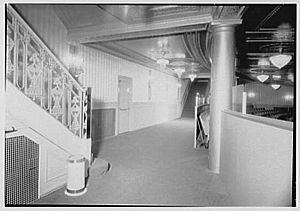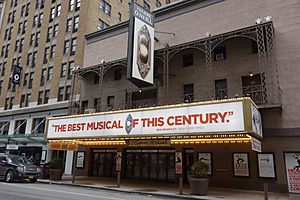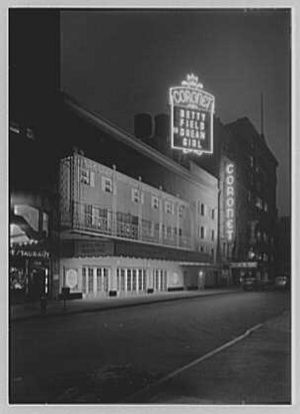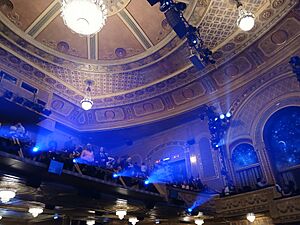Eugene O'Neill Theatre facts for kids
|
Forrest Theatre, Coronet Theatre
|
|
| Address | 230 West 49th Street Manhattan, New York United States |
|---|---|
| Coordinates | 40°45′40″N 73°59′9″W / 40.76111°N 73.98583°W |
| Public transit | New York City Subway:
|
| Owner | ATG Entertainment |
| Operator | ATG Entertainment |
| Type | Broadway |
| Capacity | 1,108 |
| Production | The Book of Mormon |
| Construction | |
| Opened | November 24, 1925 |
| Rebuilt | 1945, 1959 |
| Years active | 1925–1944, 1945–present |
| Architect | Herbert J. Krapp |
| Designated | December 8, 1987 |
| Reference no. | 1365 |
The Eugene O'Neill Theatre is a famous Broadway theater located at 230 West 49th Street in New York City. It's in the heart of the Theater District in Midtown Manhattan. Over the years, it has had other names, including the Forrest Theatre and the Coronet Theatre.
The theater was designed by architect Herbert J. Krapp and built for the famous producers, the Shubert brothers. It first opened in 1925. Today, it is named after the great American writer Eugene O'Neill. The theater can seat 1,108 people and is run by ATG Entertainment. The beautiful inside of the theater is so special that it's a New York City designated landmark.
Since 2011, the Eugene O'Neill Theatre has been home to the hit musical The Book of Mormon.
Contents
Designing a Broadway Theater
The Eugene O'Neill Theatre was designed by Herbert J. Krapp, who also designed a hotel right next to it. It was unusual at the time to build a theater and a hotel together.
The Outside of the Theater
When it was first built, the front of the theater, called the facade, was made of brick and terracotta. This matched the hotel next door. In the 1940s, the facade was changed to a smooth material called stucco.
Later, in 1980, the front was updated again with beige limestone, which is how it looks today. A large iron balcony is a key feature of the building's front.
Inside the Theater
The inside of the theater, called the auditorium, is decorated in the elegant Adam style. This style uses classical designs, light colors, and detailed patterns. The auditorium has a main orchestra level and a large balcony.
The walls and ceiling have beautiful plaster decorations. The stage is framed by a large, decorative arch called a proscenium. On the sides of the stage, there are special seating areas called boxes, which are set inside decorative arches.
When the theater first opened, it was decorated in red and gold. In 1945, the colors were changed to blue and gray. After a renovation in 1994, the theater was decorated in purple and gold.
History of the Theater
The area around Times Square became the center of New York's theater world in the early 1900s. The Shubert brothers were very important producers who built many theaters in the area, including this one.
The Forrest Theatre (1925–1945)
The theater opened on November 24, 1925, as the Forrest Theatre. It was named after Edwin Forrest, a famous actor from the 1800s. The first show was a musical called Mayflowers. For several years, many of the shows at the Forrest were not successful.
Things changed in 1934 when the play Tobacco Road moved to the theater. It became a huge hit and ran for about 3,180 performances. At the time, this made it the longest-running show in Broadway history.
The Coronet Theatre (1945–1959)
In 1945, the theater was sold and got a major makeover. It was renamed the Coronet Theatre because the old name was thought to be unlucky. The new owners hoped for a fresh start.
The Coronet had many successful shows. These included Arthur Miller's famous play All My Sons in 1947. Another hit was a revival of the play Diamond Lil starring the actress Mae West in 1949.
The Eugene O'Neill Theatre (1959–Present)
In 1959, an investor named Lester Osterman bought the theater. He renamed it after his favorite playwright, Eugene O'Neill. This was the first time a Broadway theater was named for a playwright.
Neil Simon's Ownership
In 1967, the famous playwright Neil Simon bought the theater. He staged many of his own hit plays there, including:
- Last of the Red Hot Lovers (1969)
- The Prisoner of Second Avenue (1971)
- California Suite (1976)
During the 1960s, the theater also hosted the popular play Rosencrantz and Guildenstern Are Dead.
Jujamcyn Theaters Takes Over
In 1982, a company called Jujamcyn Theaters bought the Eugene O'Neill. One of the first big hits under their management was the musical Big River in 1985. It ran for over 1,000 performances.
In 1987, the inside of the theater was officially made a New York City landmark to protect its historic design.
Other major hits in the 1990s included a revival of Cat on a Hot Tin Roof and the long-running musical Grease!, which opened in 1994.
The 21st Century
The new century brought more successful shows. The Full Monty ran for over two years starting in 2000. The rock musical Spring Awakening was another big hit, opening in 2006.
In March 2011, the musical The Book of Mormon opened. It became a massive success, winning many awards and breaking box office records for the theater. The show has been running at the Eugene O'Neill ever since.
Famous Shows at the Theater
Here are some of the most well-known productions from the theater's long history.
Forrest Theatre
- Women Go on Forever (1927)
- On the Spot (1930)
- Tobacco Road (1934)
- Three Men on a Horse (1942)
Coronet Theatre
- Dream Girl (1945)
- All My Sons (1947)
- Diamond Lil (1949)
- The Children's Hour (1952)
- A View from the Bridge (1955)
- Saint Joan (1956)
Eugene O'Neill Theatre
- A Thousand Clowns (1962)
- She Loves Me (1963)
- The Odd Couple (1966)
- Rosencrantz and Guildenstern Are Dead (1968)
- Last of the Red Hot Lovers (1969)
- Big River (1985)
- M. Butterfly (1988)
- Cat on a Hot Tin Roof (1990)
- Grease (1994)
- Death of a Salesman (1999)
- The Full Monty (2000)
- Spring Awakening (2006)
- The Book of Mormon (2011)
Box Office Record
The Book of Mormon holds the box office record for the Eugene O'Neill Theatre. In one week at the beginning of 2015, the show earned $2,224,280 over nine performances.
Images for kids
See also
- List of Broadway theatres
- List of New York City Designated Landmarks in Manhattan from 14th to 59th Streets









